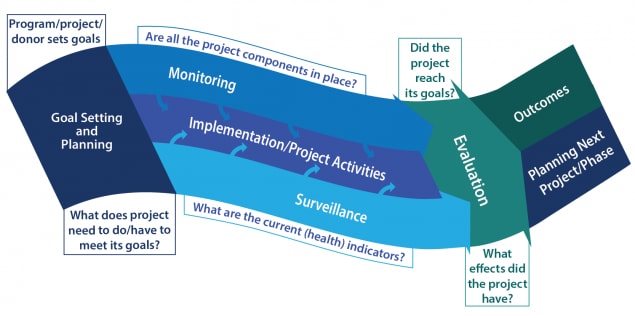Monitoring and Evaluating Maternal and Child Health Programs
CDC’s Division of Reproductive Health works with health agencies to strengthen their Monitoring and Evaluation (M&E) systems and skills. With effective M&E systems, countries and programs can collect and analyze data to document and track improvements in maternal and perinatal health and to adjust their approaches along the way when necessary.
The Role of Monitoring and Evaluation

Monitoring and Evaluation (M&E) is important for a health program or initiative to remain on track and reach its goals. Implementing or adapting surveillance systems may be a component of monitoring and evaluation activities. Successful M&E may include the following elements:
- Monitoring a program’s progress toward its programmatic goals, by periodically collecting program data (such as counting the number of midwives trained in emergency obstetric care) and tracking it over time against the desired outcome.
- Evaluating the program’s success in reaching its goals, such as its effect on short- and long-term outcomes using tailored study designs and tools.
- Surveillance of the population’s health status through ongoing detection, investigation, and reporting of health events, then analyzing these indicators to see if they’re improving and providing an early warning to the program if they are not.
CDC Technical Assistance to Monitoring and Evaluation in the Field
Recent CDC M&E work has included the following activities:
- Counting all maternal deaths in areas where maternal mortality had never before been directly measured.
- Investigating the causes, circumstances, and preventability of each maternal death to learn how future deaths might be prevented.
- Documenting the reductions in specific causes of maternal death, such as obstetric hemorrhage and sepsis (infection).
- Intensive monitoring of every birth outcome (for both mother and infant) in health facilities.
- Monitoring the implementation of project interventions, such as improving health facilities and transportation and referral systems.
- Using Geographic Information System (GIS) mapping to evaluate project advancement.
- Designing tools, questionnaires, trainings, and data management systems so programs can collect and analyze their data in a scientifically sound manner.
In particular, CDC has worked with the Saving Mothers, Giving Life initiative (SMGL) and the Maternal and Reproductive Health in Tanzania project to:
- Develop systems to improve the identification and reporting of maternal deaths (surveillance).
- Implement facility-based systems to monitor the quality of emergency obstetric care (monitoring)
- Document and evaluate project progress toward achieving goals for reductions in mortality, and improvements in quality of care (evaluation).
CDC’s M&E activities produced the evidence that:
- SMGL activities reduced maternal mortality in SMGL districts by 44% in Uganda and by 41% in Zambia.
- The Maternal and Reproductive Health in Tanzania project in Kigoma region contributed to reducing the maternal mortality ratio in facilities there by 52% in 5 years.